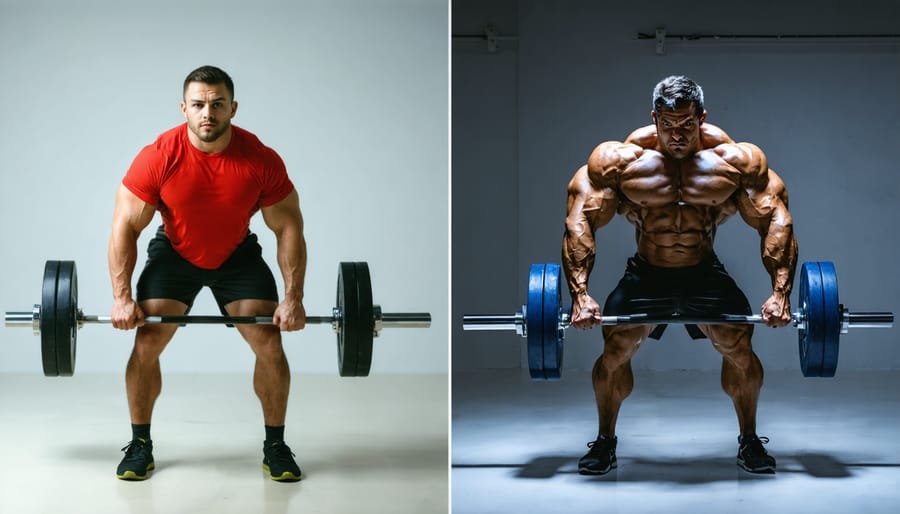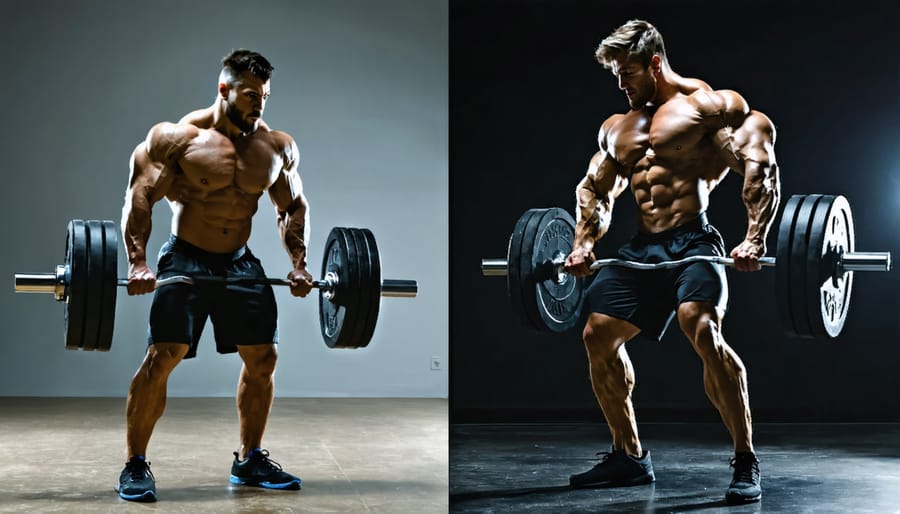Discover the fundamental difference between strength training and bodybuilding through their distinct core purposes: strength training fundamentals focus on maximizing functional power and athletic performance, while bodybuilding prioritizes muscle size and aesthetic development. Each path demands unique training approaches, nutrition strategies, and mental preparation.
While both disciplines build muscle and enhance fitness, strength training emphasizes compound movements and progressive overload to develop raw power and functional strength. Bodybuilding, conversely, incorporates isolation exercises and higher repetition ranges to sculpt specific muscle groups and achieve optimal physical symmetry.
The choice between these training styles depends entirely on your personal goals. Athletes and those seeking practical strength gravitate toward strength training’s performance-based approach. Individuals focused on physical appearance and muscle definition often find bodybuilding’s targeted muscle development more aligned with their objectives.
Both methods offer significant health benefits, from increased bone density to improved metabolic health, making either choice valuable for overall wellness. Understanding these distinctions enables you to make an informed decision about which path best serves your fitness journey.
Understanding the Core Differences

Training Goals and Philosophy
Strength training and bodybuilding, while related, have distinct training goals and philosophies that shape their approach to exercise. Strength training primarily focuses on increasing functional strength and power, with emphasis on improving performance in basic movement patterns. The goal is to lift heavier weights progressively while maintaining proper form, regardless of aesthetic outcomes.
In contrast, bodybuilding centers on muscle hypertrophy (growth) and achieving a specific physical appearance. Bodybuilders typically focus on isolating individual muscle groups and performing higher repetitions with moderate weights to create muscle definition and symmetry.
Training volume and intensity also differ between these approaches. Strength trainers usually perform fewer repetitions (1-5) with heavier weights and longer rest periods, prioritizing maximum force production. Bodybuilders often incorporate more exercises per muscle group, higher repetitions (8-15), and shorter rest periods to achieve muscle fatigue and stimulate growth.
Both approaches can improve overall fitness and health, but choosing between them depends on your personal goals. Whether you want to boost functional strength or enhance muscle definition, understanding these different philosophies helps guide your training decisions.
Exercise Selection and Programming
Strength training and bodybuilding involve distinct exercise selections and programming approaches to achieve their specific goals. Strength training typically focuses on compound movements like squats, deadlifts, bench presses, and overhead presses, performed with heavy weights and lower repetitions (usually 1-5 reps). These exercises engage multiple muscle groups simultaneously and are programmed with longer rest periods between sets, typically 3-5 minutes.
In contrast, bodybuilding incorporates both compound and isolation exercises, such as bicep curls, lateral raises, and leg extensions. The emphasis is on targeting individual muscle groups with moderate weights and higher repetitions (8-15 reps). Bodybuilding workouts often include techniques like supersets, drop sets, and shorter rest periods (30-90 seconds) to maximize muscle tension and growth.
Training frequency also differs between the two approaches. Strength athletes might train each movement pattern 2-3 times per week, while bodybuilders often follow a split routine, training different muscle groups on separate days to allow for adequate recovery and volume. Both methods can be effective, but your choice should align with your personal fitness goals and preferences.
Health Benefits of Strength Training
Functional Strength and Daily Life
One of the most compelling benefits of strength training is its direct impact on daily activities. Unlike bodybuilding, which primarily focuses on aesthetic improvements, strength training develops functional fitness that makes everyday tasks easier and safer.
When you regularly engage in strength training, simple activities like carrying groceries, moving furniture, or playing with children become less challenging. The increased muscle strength and improved joint stability help prevent injuries during routine movements, such as lifting boxes or reaching for items on high shelves.
For older adults, strength training is particularly valuable in maintaining independence. It helps preserve the ability to climb stairs, get up from chairs, and perform household chores without assistance. The enhanced core strength and balance also reduce the risk of falls, a common concern among seniors.
Working professionals benefit from better posture and reduced strain during long hours at desk jobs. Parents find it easier to keep up with their children’s energy levels, and weekend warriors can enjoy their recreational activities with less fatigue and greater confidence.
This practical application of strength makes it an invaluable investment in your quality of life, ensuring you can maintain an active, independent lifestyle well into your later years.

Bone Health and Injury Prevention
Both strength training and bodybuilding offer significant benefits for bone health, though they work in slightly different ways. Strength training, particularly with compound movements like squats and deadlifts, creates beneficial stress on bones that stimulates mineral density growth. This process, known as bone remodeling, helps build stronger, more resilient bones over time.
Bodybuilding routines also contribute to bone health, though the focus on isolation exercises may provide less direct bone-strengthening benefits compared to heavy compound movements. However, the consistent resistance training involved in bodybuilding still promotes healthy bone density and reduces the risk of osteoporosis.
When it comes to injury prevention, both approaches have their merits. Strength training emphasizes proper form and movement patterns, which helps develop functional strength and stability. This translates to better joint health and reduced risk of everyday injuries. The balanced muscle development from strength training also helps maintain proper posture and body alignment.
Bodybuilding’s attention to muscle isolation and controlled movements can help identify and address muscle imbalances, reducing the risk of strain or overuse injuries. The focus on proper form and mind-muscle connection also promotes better body awareness, which is crucial for injury prevention.
Regular practice of either discipline, when performed with proper technique and appropriate progression, can significantly reduce the risk of falls and injuries as you age. The key is to start gradually and maintain consistency in your chosen training approach.
Metabolic and Hormonal Benefits
Both strength training and bodybuilding offer significant metabolic and hormonal advantages, though they affect your body in slightly different ways. Strength training typically promotes a higher release of growth hormone and testosterone, which are crucial for muscle development and overall health. These hormones help maintain healthy bone density, improve energy levels, and support better sleep patterns.
Bodybuilding’s higher-volume approach creates a substantial metabolic response, leading to increased calorie burn both during and after workouts through excess post-exercise oxygen consumption (EPOC). This “afterburn effect” can last for several hours, supporting weight management goals.
Both training styles effectively increase insulin sensitivity, which helps regulate blood sugar levels and reduce the risk of type 2 diabetes. They also boost your resting metabolic rate by increasing muscle mass, meaning you’ll burn more calories even when you’re not exercising.
The key hormonal difference lies in the recovery patterns. Strength training’s lower volume but higher intensity approach typically allows for better hormone optimization between sessions, while bodybuilding’s higher volume may require more careful recovery management to maintain optimal hormone levels.
For the best metabolic benefits, consider your personal goals and schedule. If you’re looking to maximize hormone production with fewer weekly sessions, strength training might be your better option. If you enjoy longer workouts and want to maximize calorie burn, bodybuilding-style training could be more suitable.
Health Considerations in Bodybuilding
Muscle Development and Aesthetics
Bodybuilding-style training focuses primarily on enhancing muscle size and achieving a specific aesthetic appearance through targeted exercises and precise nutrition. This approach involves understanding the muscle growth process and manipulating training variables to maximize hypertrophy.
The benefits of bodybuilding training include improved muscle definition, enhanced body composition, and increased metabolic rate. This style of training typically involves higher repetition ranges (8-12 reps) and multiple sets, which creates the necessary muscle tension and metabolic stress for optimal muscle growth.
However, bodybuilding comes with its own set of challenges. The strict dietary requirements and dedicated training schedules can be demanding, requiring significant time commitment and discipline. Additionally, the focus on isolation exercises and specific muscle groups means workouts tend to be longer than traditional strength training sessions.
For those interested in aesthetic development, bodybuilding offers detailed attention to muscle symmetry and proportions. The training typically includes a variety of exercises for each muscle group, ensuring comprehensive development from multiple angles. This approach can be particularly effective for those looking to address muscle imbalances or achieve specific physique goals.
While bodybuilding may not maximize absolute strength gains, it excels at creating the defined, muscular appearance many fitness enthusiasts desire.
Physical and Mental Demands
Both strength training and bodybuilding make significant physical and mental demands on practitioners, though their specific requirements differ notably. Strength training typically involves shorter, more intense workouts focusing on compound movements and progressive overload. These sessions usually last 45-60 minutes, requiring mental focus on proper form and technique rather than aesthetic concerns.
Bodybuilding, on the other hand, often demands longer training sessions, sometimes lasting up to two hours, with higher volume and more isolation exercises. The mental commitment extends beyond the gym, as bodybuilders must maintain strict dietary control and meal timing to support muscle growth and definition.
Both disciplines require careful attention to nutrition, but bodybuilding tends to be more restrictive. Bodybuilders often follow precise meal plans with specific macronutrient ratios and may need to cycle through bulking and cutting phases. Strength trainers typically focus on meeting daily protein requirements and maintaining adequate energy levels for performance.
Recovery demands also differ. Strength training usually allows for more rest days between sessions due to the intensity of the workouts. Bodybuilders often train more frequently, targeting different muscle groups on separate days, which requires careful planning of rest and recovery periods.
The mental discipline required for both pursuits shouldn’t be underestimated. Consistent progress demands dedication, patience, and the ability to push through plateaus while maintaining proper form and avoiding injury.
Making the Right Choice for Your Goals

Personal Assessment Factors
Choosing between strength training and bodybuilding depends on several personal factors that can help guide your decision. First, consider your primary fitness goals. If you’re aiming to build overall strength and improve daily function, strength training might be your best choice. If aesthetic improvements and muscle definition are your priorities, bodybuilding could be more aligned with your objectives.
Your schedule and time commitment also play a crucial role. Strength training typically requires fewer weekly sessions and shorter workouts, making it more manageable for busy individuals. Bodybuilding often demands more frequent training sessions and detailed attention to meal timing and preparation.
Current fitness level and experience matter too. Beginners might find strength training’s fundamental movements easier to master initially. Those with more training experience might be ready for bodybuilding’s varied exercises and advanced techniques.
Consider your body type and natural build. Some people respond better to certain training styles based on their genetics and muscle fiber composition. Your age and overall health status should also influence your choice, as strength training often provides a gentler approach for older adults or those with joint concerns.
Remember that your preference for training style matters. Choose the method you enjoy and can maintain consistently, as this will lead to better long-term results. You can also combine elements of both approaches as you progress in your fitness journey.
Creating a Balanced Approach
Creating an effective fitness routine doesn’t mean choosing strictly between strength training and bodybuilding – you can actually benefit from combining elements of both approaches. The key is to align your training with your personal goals while maintaining overall health and functionality.
Start by establishing your primary objectives, whether that’s building strength, increasing muscle mass, or improving overall fitness. Then, structure your weekly routine to incorporate both training styles. For example, you might dedicate three days to compound movements with heavier weights and lower reps (strength focus), and two days to isolation exercises with moderate weights and higher reps (bodybuilding focus).
This balanced approach helps you develop both functional strength and aesthetic improvements while helping to overcome training plateaus. Consider implementing periodization, where you cycle through different training phases throughout the year, emphasizing either strength or hypertrophy depending on your current goals.
Remember to maintain proper form regardless of the training style, and ensure adequate recovery between sessions. Include complementary elements like proper nutrition, sufficient sleep, and stress management to support your combined training approach. This balanced method not only promotes sustainable progress but also helps prevent burnout and reduces the risk of injury while maximizing your overall fitness results.
Both strength training and bodybuilding offer valuable paths to improved fitness and health, each with distinct advantages. Strength training provides functional benefits ideal for everyday activities, sports performance, and long-term health maintenance. Bodybuilding excels in muscle development, aesthetic improvements, and detailed physique enhancement. Your choice should align with your personal goals, lifestyle, and preferences.
Consider starting with basic strength training to build a solid foundation, regardless of your ultimate fitness destination. You can always incorporate bodybuilding principles later if aesthetic goals become important. Remember that these approaches aren’t mutually exclusive – many successful fitness enthusiasts combine elements of both to achieve well-rounded results.
The key is consistency and proper form in whichever path you choose. Consult with qualified fitness professionals to develop a program that suits your needs and supports your long-term health objectives.

